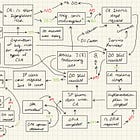The infamous chat control proposal is back on the EU agenda. I have written about this legislation previously, which would require certain online platforms to detect and prevent instances of child sexual abuse activity taking place on their services.
There are clear dangers to E2EE and data protection with this proposal. But I think to navigate the debat…
Keep reading with a 7-day free trial
Subscribe to The Cyber Solicitor to keep reading this post and get 7 days of free access to the full post archives.



